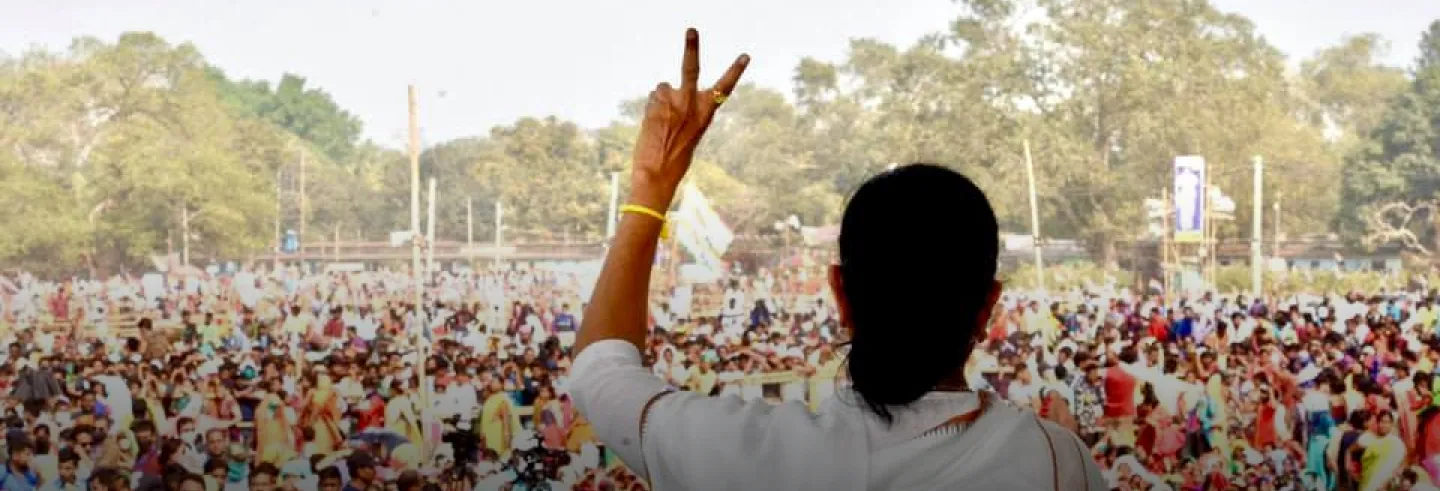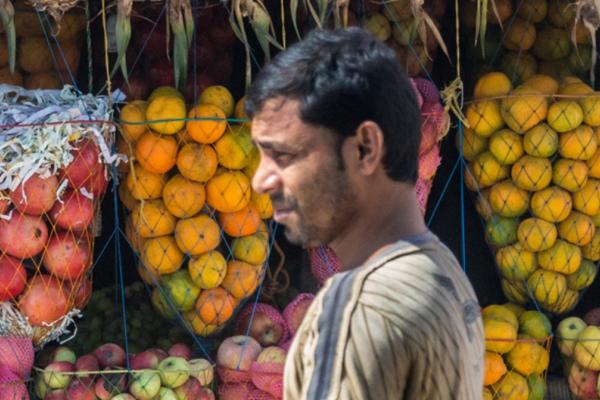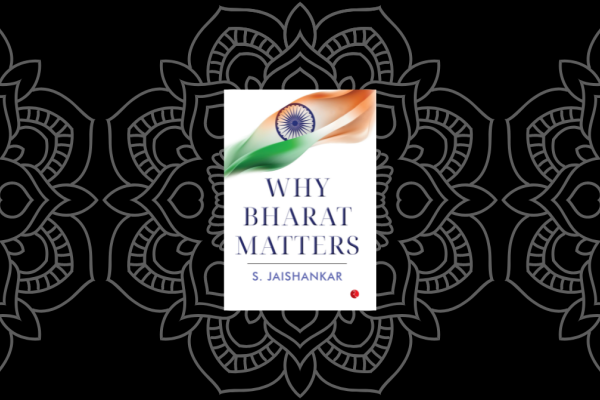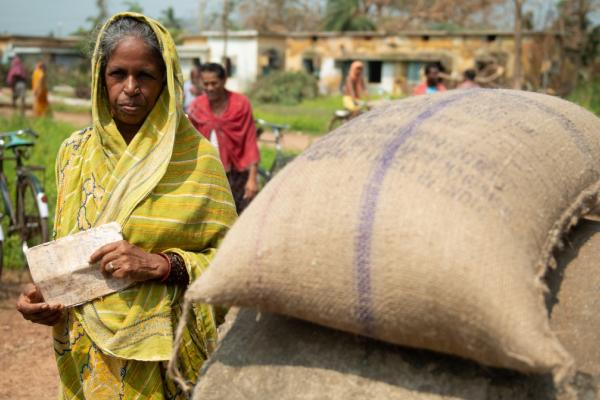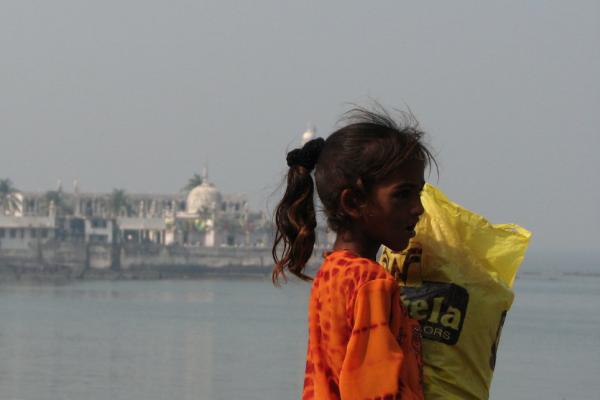That the BJP and its allies would lose in Tamil Nadu, get wiped out in Kerala, retain their government in Assam, and gain in Puducherry in the latest round of assembly elections was widely anticipated. The West Bengal elections, on the other hand, kept everyone on the tenterhooks, with most exit polls predicting a close finish. In the end, it turned out to be an emphatic victory for the incumbent Mamata Banerjee-led TMC that returned with a two-thirds majority.
The BJP's becoming the principal opposition in the state assembly with 77 seats is not insignificant, given that it won only 3 seats in the last assembly elections. But the desperation shown by the BJP in grabbing power in Bengal, by hook or by crook, clearly backfired. Building upon its striking performance in West Bengal in the 2019 Lok Sabha elections, the BJP had embarked on a propaganda blitz led by Prime Minister Narendra Modi against the TMC regime. It banked on anti-incumbency, communal polarisation, and consolidation of identitarian support from various social groups.
The over-reliance on TMC defectors badly backfired on the BJP, with a section of its core support base getting alienated.
The BJP’s electoral game plan for 2021 was to try and erode a fraction of the ruling party's base and bridge the BJP's organisational deficit through large-scale defections from the TMC. The BJP lured away a significant number of TMC senior leaders, including key lieutenants of Banerjee like Suvendu Adhikari and Mukul Roy. Despite these attempts, the BJP failed to project any Bengali leader as a credible challenger to Banerjee. The over-reliance on TMC defectors badly backfired on the BJP, with a section of its core support base getting alienated. In the final tally, the TMC secured around 48% of the vote, 10% more than the BJP's.
While anti-incumbency against the state government, along with a general pro-BJP current after the Pulwama-Balakot incidents, were factors driving BJP's rise in 2019, anti-incumbency against the Modi government prevailed in 2021. This is a clear reaction to the severe socio-economic distress caused by Modi’s mishandling of the Covid-19 pandemic over the past year. As per official estimates, 13.84 lakh migrant workers returned to West Bengal during the lockdown in 2020, which is the third-highest after UP and Bihar. Besides their traumatic ordeal following the sudden lockdown last year, the return of such a large number of working-age persons aggravated the already grave unemployment situation. The unemployment rate in West Bengal averaged 11.4% from August to November 2020, much above the national average of 7% during this period, as per the CMIE's monthly series on unemployment.
People have overwhelmingly favoured a secular alternative, however venal it may otherwise be, over BJP's majoritarian and exclusivist Hindutva politics.
The BJP's attempts to polarise the elections on communal lines also had a counter-productive impact. Results of the post-poll survey conducted by the Lokniti-CSDS show that while TMC's electoral support within Muslims increased to 75% in 2021 from 70% in 2019, its support within Hindus has also increased to 39% from 32%. The BJP's support within the Hindus fell to 50% from 57%. In a state where Muslims comprise over 27% of the population, people have overwhelmingly favoured a secular alternative, however venal it may otherwise be, over BJP's majoritarian and exclusivist Hindutva politics.
2014 to 2019: The BJP’s rise and the decline of the Left
The BJP's prominence in West Bengal is a very recent phenomenon. Their highest vote share in West Bengal had been 11.7%, attained in 1991 in the backdrop of the Ram Mandir movement. It was the Modi wave of 2014 that enabled the BJP to better that with a 17% vote share.
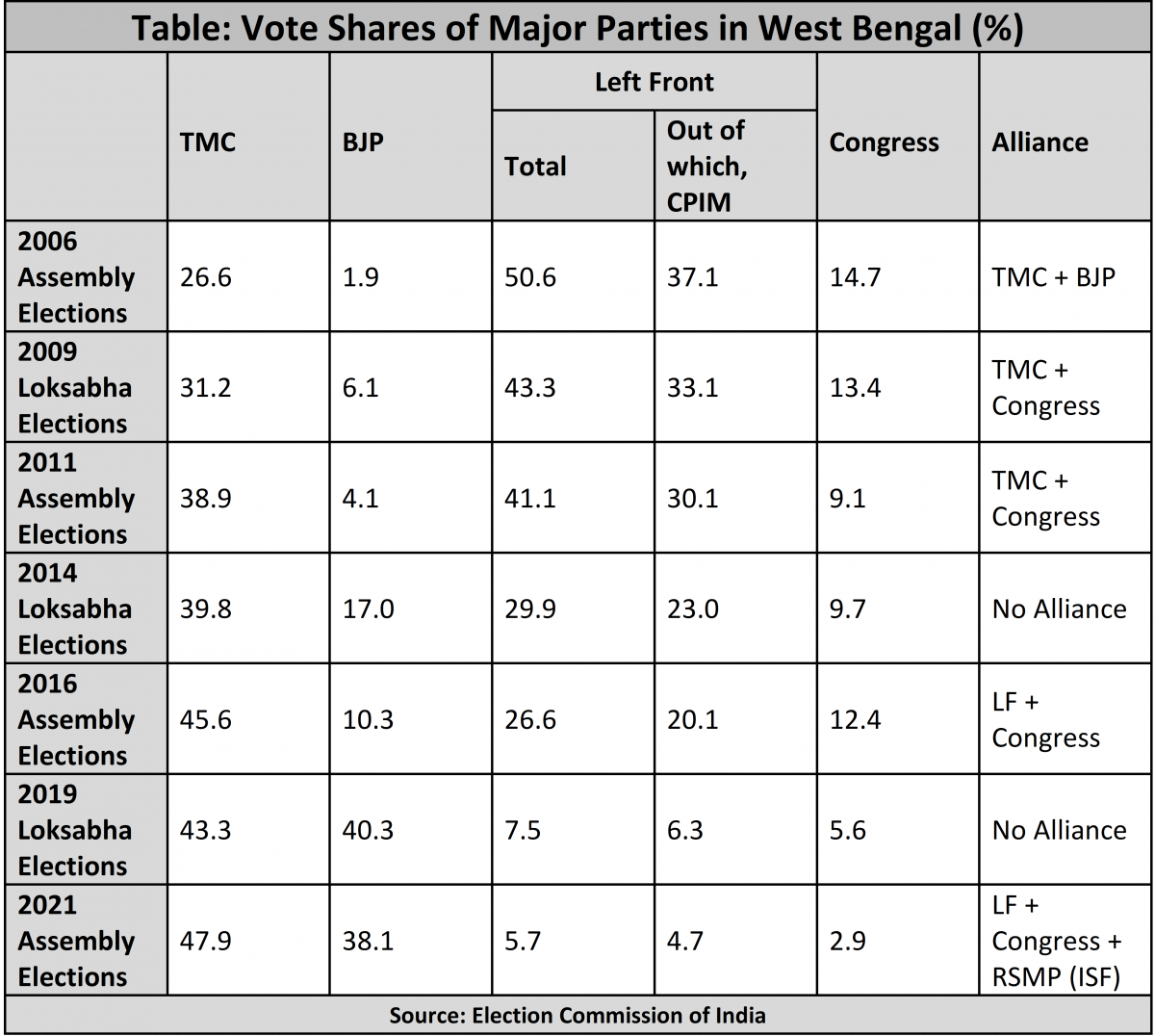
Much of this gain was from declining support for the LF. The vote shift from the LF to the BJP can be attributed to three mutually reinforcing factors — disenchantment with the CPI(M)-led LF and loss of faith in its leadership; the need for protection and security against the aggression of the TMC cadres; and the perception of a 'Muslim-bias' in Mamata Banerjee's policies.
Post-partition refugees from East Bengal, though traditionally CPI(M) voters, have been susceptible to the BJP's communal rhetoric, especially on issues like ‘Bangladeshi infiltration’.
The CPI(M) leadership, while being vocal on the latter two points ignored the most important factor behind this shift: the growing trust deficit among their supporters owing to their refusal to rectify the errors which led to the downfall of the LF government in 2011. Elements within the CPI(M) leadership in West Bengal have, in the past, been willing to do business with the BJP to settle factional scores, notwithstanding the party’s line. 1 BJP's consecutive victories from the Dum Dum Lok Sabha constituency in 1998 and 1999 securing over 50% votes were attributable to the factional battles within the CPI (M)'s North 24 Parganas leadership, with one faction not-so-secretly transferring votes to the BJP with a sinister slogan, 'chup chap, fuley chhap' [silently, stamp on the flower symbol]. BJP fought the Loksabha elections in West Bengal in 1998 and 1999 in alliance with thethen newly formed TMC, which broke away from the Congress in 1997-98. Moreover, post-partition refugees from East Bengal, though traditionally CPI(M) voters, have been susceptible to the BJP's communal rhetoric, especially on issues like ‘Bangladeshi infiltration’.
The CPI(M)’s alliance with its one-time bête noire Congress ahead of the 2016 assembly elections further weakened the LF, which finished third after TMC and Congress. The opposition was further weakened when the TMC started engineering defections from Congress and LF. In the backdrop of this growing void in the opposition space a string of communal riots occurred in West Bengal in multiple locations across districts. Religious festivals like Durga Puja, Muharram, and Ram Navami, as well as local disputes and provocations, were utilised by the BJP and other Sangh Parivar outfits to precipitate violent confrontations, at times provoking retaliatory action by Muslims. Effective deterrent action by the government was either missing or delayed. The overall impact was felt in growing communal polarisation, and the BJP's vote share in bye-elections increased at the cost of the LF.
Widespread violence perpetrated by TMC during the 2018 panchayat elections created a huge reservoir of rural discontent. This helped BJP to emerge as the most significant grassroots level opposition.
The other key reason for the BJP’s rise was the inability of both the LF and the Congress to organizationally withstand TMC's ruthless aggression at the village level. The widespread violence perpetrated by the TMC during the 2018 panchayat elections created a huge reservoir of rural discontent. This helped the BJP to emerge as the most significant grassroots level opposition to the TMC across rural Bengal.
As the LF and Congress leadership capitulated across the state, the BJP leadership stepped in with its resources and central support. The anonymously coined Agey Ram, Porey Bam (First for Ram, then for the Left) slogan gripped the erstwhile LF voters causing an en masse shift to the BJP. In the 2019 parliament elections, BJP's vote share rose to 40.3%, translating into 18 Lok Sabha seats. The BJP’s rise was at the cost of the LF’s vote share, which fell to 6.3 % from 26.6 % and the Congress’, which fell to 5.6% from 12.4%. For the first time after gaining power in the state, TMC's vote share also fell, by 2.2 percentage points. BJP’s gain was more pronounced in the SC and ST reserved constituencies. While it had swept North Bengal and Jangal Mahal, the BJP also made major gains in the Durgapur-Asansol mining-cum-industrial belt of Bardhaman as well as the Namasudra-Matua refugee belt of Nadia and North 24 Parganas.
2021: A vote against the centre
The second wave of Covid-19 struck in April 2021, amidst the unjustifiably protracted eight-phase election in West Bengal, and decisively turned the tide against the BJP. Compared with 2019, there was a positive swing in favour of TMC in all the phases but one.
An analysis by Ghatak and Maitra corroborates the trend of TMC's vote share increasing and BJP's falling with the progress of the phases. It also reveals that the TMC benefited more from the collapse of the vote share of the LF and the Congress, particularly in the last three phases, which they attribute to the surge in Covid-19 cases. One may add that the Sitalkuchi firing on the polling day of the fourth phase which killed four persons from the minority community; and the consequent rhetoric of the BJP leadership, threatening more such atrocities by the central forces, also contributed to the consolidation of anti-BJP votes behind the TMC. Despite being an assembly election, people emphatically voted against the centre and not the state government.
The rise in the TMC's vote share among the marginalised social groups in 2021 can be partly explained by the popularity of the government’s welfare schemes for the poor, especially women.
Overall, the TMC appears to have retrieved some of the ground it had lost to the BJP among the Dalits and Adivasis, although the vote share difference between the TMC and the BJP is the least within the reserved constituencies. Within the 68 seats reserved for SCs, TMC won 36, BJP 32; in the 16 ST reserved seats, 9 went to the TMC, 7 to the BJP. Moreover, 12 SC MLAs have been elected from unreserved seats in 2021, out of which 8 have won from the TMC. The Lokniti-CSDS post-poll survey also shows that 50% of women voted for the TMC, with even higher support among women from poor, low-income families.
The rise in the TMC's vote share among the marginalised social groups in 2021 can be partly explained by the popularity of the government’s welfare schemes for the poor, especially women. This includes post-lockdown free rations through the PDS which was extended till June 2021, the public-funded health insurance scheme 'Swasthya Sathi' and the outreach programme in local areas for welfare scheme enrolment and quick delivery of SC/ST/OBC certificates titled 'Duarey Sarkar', launched a few months ahead of the election. The earlier schemes like cash transfer for girl-child, 'Kanyashree' and distribution of cycles to school children in IX-XII standards, 'Sabooj Sathi' also had a discernible impact. These schemes helped in checking public discontent over the violence of the 2018 panchayat polls, the initial mismanagement of the pandemic, and widespread theft of relief funds meant for the Amphan cyclone-affected families in 2020. The results were also helped by Mamata Banerjee’s attempts to shed her perceived ‘Muslim bias’ by adopting policies like doling out Rs 50,000 each for over 37,000 Durga Puja committees across the state.
Notwithstanding its impressive electoral successes, TMC's governance record does not enthuse much confidence. Slippages on the part of the chief minister can quickly bring the BJP back on the offensive.
With the leaders of the farmers' movement actively campaigning against the BJP in West Bengal, the three farm laws of 2020 became a significant issue in the election alongside other economic grievances against the centre like economic slowdown, rising fuel prices, across-the-board privatisation of banks, insurance companies, railways etc. and undue favours being meted out to crony corporate houses. Additionally, with the BJP promising to implement the CAA in their West Bengal manifesto, the movement groups against NRC-NPR-CAA 2003 and CAA 2019 campaigned vigorously against the BJP for making false promises of citizenship to the Dalit refugees like Matua-Namasudras, for demanding fresh NRC in Assam and for trying to rob the citizenship of millions of East Bengal refugees, Dalits and minorities in Bengal through the NRC-NPR process. Besides, several other activist groups and cultural luminaries carried out energetic campaigns against the BJP, both on the ground and online, all of which had a combined impact on the electoral outcome.
Although BJP's defeat in West Bengal has come as a relief for many, the party has managed to emerge as the main opposition in the state. This gives the BJP an opportunity to consolidate their base and make a bid for power in future. Notwithstanding its impressive electoral successes, TMC's governance record does not enthuse much confidence. Slippages on the part of the chief minister can quickly bring the BJP back on the offensive.
What lies ahead for the Left?
Only a revival of the Left can stem BJP’s rise in the long run. Given the fact that LF has ended with zero seats in the assembly, however, this will be an onerous task. The game is up for CPI(M) and LF in West Bengal unless there is a very drastic overhaul including a replacement of its discredited state leadership and a change in its erroneous political line.
If the CPI(M) melts away, it will fall upon the smaller Left forces outside the CPI(M) to regroup and re-imagine a new Left alternative in West Bengal.
The political line pursued by the LF in the 2021 elections, that there was no difference between the TMC and the BJP, was sheer folly in a context where the BJP had already emerged as the main opposition in 2019. The call to defeat 'Bijemool' — a term coined by the CPI(M) to portray how the TMC and BJP were similar — sent out perverse signals regarding sections of the LF providing tacit support to the BJP. The LF and Congress’ alliance with the newly formed Indian Secular Front of the Islamic cleric Abbas Siddiqui, with neither a transparent common programme nor a smooth seat-sharing deal, drew flack for compromising on secularism and trying to divide secular votes in the fight against BJP. (The ISF won the only seat which accrued to the alliance.)
The possibility of any course correction from within the CPI(M) seems distant. If the CPI(M) melts away, it will fall upon the smaller Left forces outside the CPI(M) to regroup and re-imagine a new Left alternative in West Bengal. Will the new Left reconcile with the BJP's rise in West Bengal at the cost of the old Left, build bridges with the TMC regime and become Mamata Banerjee's junior partner in staving off BJP's power bid in Bengal? Or will it try and win back the erstwhile LF mass base, especially the disillusioned subaltern classes which have migrated to both the BJP and the TMC; through independent, democratic movements against both the Modi and the Mamata regimes? The main concern vis-à-vis that trajectory would be to stay clear of the 'Bijemool' trap. Unfolding events indicate that the Modi regime would now pull out all stops to corner and destabilize the newly elected West Bengal government.
Unconstitutional transgressions of the Modi regime have to be fought back unhesitatingly and priority accorded to building a nationwide popular movement to oust the Modi regime in 2024. If that can be accompanied by local struggles against the TMC regime, alongside re-imagining a new Left programme grounded in contemporary global and Indian realities, such efforts can have a bright future in West Bengal. Such a new Left in West Bengal can break the stranglehold of the complacent, upper-caste, upper-class leadership and reconnect with the socially oppressed and the economically exploited.


